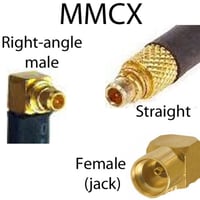Antennas with U.FL connector
U.FL Antennas
Data Alliance can customize most of our antennas that have cables, to have a U.FL connector on the cable, for orders of 40 or more.
About U.FL Connectors
U.FL is a key low impedance connector type for antennas for Bluetooth Beacons, an ever expanding range of Internet of Things (IOT) applications, WiFi, RFID (Radio Frequency ID), and GPS.
The U.FL coaxial connector, originally designed by Japanese electronics company Hirose, consists of a surface-mounted male part and female part that is attached to the antenna or a connecting cable. This mating connection keeps impedance to a minimum.

U.FL Antennas: How To Install and Care for U.FL Connectors
Data Alliance offers a U.FL insertion tool, to aid in the installation (and disconnection of the connector, if necessary) of the U.FL female right-angle connector at the end of the antenna's cable, to a male U.FL jack (male U.FL connector) embedded in a device's circuit board. When the external antenna is connected to the jack, signal transmission and receiving power will be diverted to it via this connection.
Care and Maintenance of a U.FL Cable and Connector
It is important to note that though a range of external antennas and antenna cables come with U.FL connectors, this connection was not originally designed for frequent detachment and reattachment. Care also should be taken with exposure of the connection to air, moisture and dirt which will increase impedance at the connection and thus impair the functioning of the antenna.

Disable an Internal Antenna Where Present
If an internal (or surface mounted) antenna is also present, this will have to be disabled or disconnected for diversion of the TX/RX via the U.FL jack to the external U.FL antenna.
Applicable Wireless Technologies and Protocols for U.FL Antennas
-
Wi-Fi (802.11 series)
- 802.11a: Operates in the 5 GHz frequency band.
- 802.11b/g/n: Functions in the 2.4 GHz frequency band.
- 802.11ac: Utilizes both 2.4 GHz and 5 GHz frequency bands.
- 802.11ax (Wi-Fi 6): A newer standard that also operates on both 2.4 GHz and 5 GHz bands but with enhanced throughput and efficiency.
-
Bluetooth
- Supports all versions of Bluetooth, including classic Bluetooth (BR/EDR) and Bluetooth Low Energy (BLE).
-
Zigbee
- Primarily operates in the 2.4 GHz frequency band. U.FL antennas facilitate reliable communication in Zigbee-based smart home and industrial devices.
-
LoRa (Long Range)
- A long-range, low-power wireless platform that's used for building IoT networks. U.FL antennas can be seen in LoRa modules operating in various sub-GHz bands (e.g., 868 MHz in Europe or 915 MHz in the US).
-
Cellular Technologies
- U.FL antennas can also be tailored for cellular applications, supporting GSM, 3G, 4G/LTE, and even emerging 5G technologies.
-
RFID and NFC
- U.FL antennas are suitable for short-range communication protocols like RFID (Radio-Frequency Identification) and NFC (Near Field Communication).
-
Global Navigation Satellite Systems (GNSS)
- This includes systems like GPS (Global Positioning System), GLONASS, Galileo, and BeiDou. U.FL antennas designed for these frequencies can ensure accurate positioning and tracking.
-
ISM Bands
- U.FL antennas can be designed for various Industrial, Scientific, and Medical (ISM) bands, facilitating applications like remote control, telemetry, and more.
-
Sub-GHz bands
- Apart from the widely used 2.4 GHz and 5 GHz bands, U.FL antennas are also available for sub-GHz frequencies like 433 MHz, 868 MHz, and 915 MHz, which are commonly used for long-range, low-data-rate communications.








